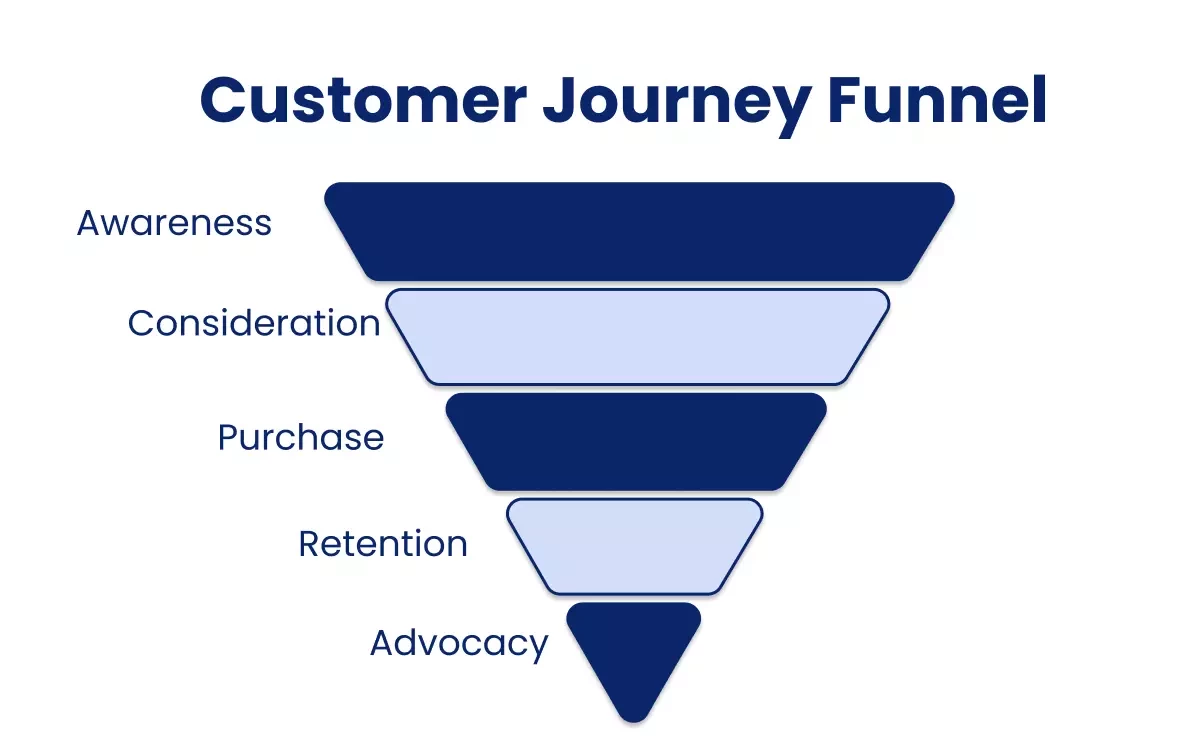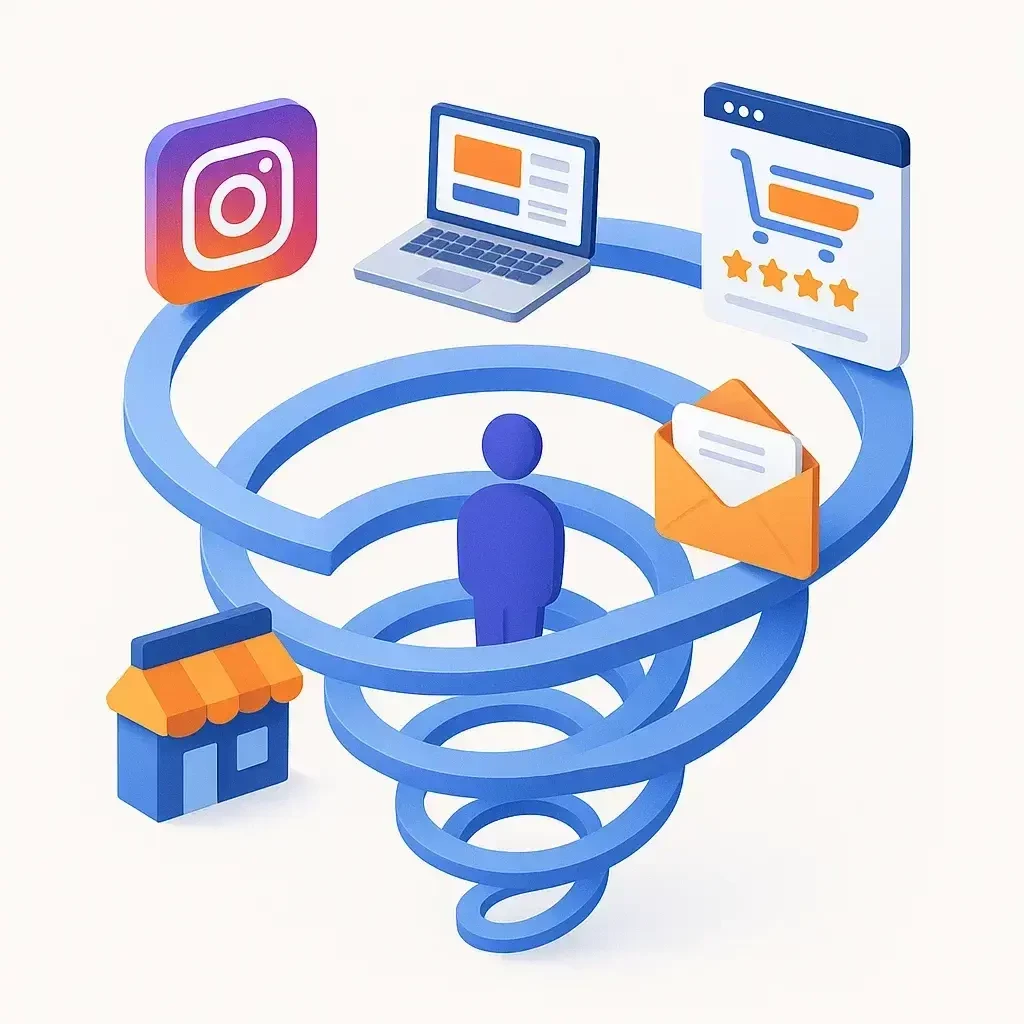Customer Journey Marketing
Customer journey marketing turns scattered clicks into a story people actually want to follow. It helps you show up with the right message, in the right channel, at the right moment—and keep doing that long after the first purchase. Less noise, more meaning. That’s the whole vibe.
What is Customer Journey Marketing
Customer journey marketing is a way to plan and execute all of your interactions with a customer that focuses on the whole route they travel with your business. You don't just run random ads and hope that something works. Instead, you make linked moments that respond to people's intentions, actions, and situations. You support individuals at every stage of their journey, from being aware of your product to trying it out, making a choice, signing up, and renewing their subscription.
This work leans on data, not hunches. You capture signals from your site, app, email, support, and social. You map typical paths, then personalize the next touch based on what someone did (or didn’t do). A well-built customer journey map serves as your organizational framework to select appropriate communication methods and performance indicators. The process requires teams to work together because marketing, sales, product and success departments need to avoid duplicate efforts. Customer journey marketing exists to deliver consistent promise fulfillment instead of creating superficially attractive campaigns.
Why Customer Journey Marketing is Crucial
People remember how you made them feel. When messages respect timing and context, customers feel guided, not chased. That boosts customer experience (CX), which boosts everything else—satisfaction, retention, referrals, and revenue. Customer journey marketing also reduces waste. You stop shouting the same generic offer at everyone and start speaking to the right segment with the right ask.
Inside the company, it’s a silos-breaker. A shared customer journey map clarifies who owns what and where handoffs fail. Budget shifts from volume to value. Onboarding gets cleaner. Post-purchase marketing becomes proactive, not reactive. Over time, you see healthier upsell and cross-sell, a rising customer lifetime value, and fewer “Why did we send that?” moments. It’s the operating system for a truly customer-centric strategy.
Main Stages of Customer Journey
Every brand’s path is unique, but most follow familiar waypoints. Treat these customer journey stages as living guides, not rigid gates. Your customer journey marketing should be flexible enough to loop, pause, and restart as real life does.

Awareness
A person realizes a need or a desire. They search, scroll, ask friends. Your job is to be discoverable and genuinely useful. Short explainers, how-tos, and social proof help here. Don’t over-promise. Seed curiosity, earn trust. Customer journey marketing at this stage focuses on matching keywords to real pain points and making the first impression frictionless.
Consideration
Now they compare. Features, pricing, implementation time, and reviews. Give them tools to decide—demos, side-by-side charts, ROI snapshots, use-case stories. A clear customer journey map helps you answer the exact questions that stall progress. Invite micro-commitments like a newsletter or a free tool to keep the conversation going.
Purchase
Make checkout quick. Fewer fields, clear delivery or activation timing, instant confirmation. Then move from “order placed” to “value unlocked.” For subscriptions, guide first-run setup. For retail, send tracking updates and care tips. In an ecommerce customer journey, follow up with a friendly nudge to create an account, set preferences, or request size/fit feedback.
Retention
This is where most brands quietly lose people. Don’t. The system should teach new features to users while honoring their achievements and detect when their engagement levels start to decline. The system maintains customer value through post-purchase marketing, including replenishment reminders, how-to emails, and in-app tips. The marketing approach of customer journey marketing works well in this context because it delivers coaching content at the right time when users need it, instead of following your scheduled plan.
Advocacy
Delighted customers share. Make it easy with referral links, review prompts, community spotlights, and creator partnerships. Feed those stories back into Awareness. When advocacy shows up, your customer journey marketing closes the loop—new people find you because the experience delivered.
How to Create a Customer Journey Map
A customer journey map is a visual of steps, emotions, and questions people move through with your brand. It doesn’t need to be fancy. It does need to be honest, current, and tied to action.
Gather the right inputs
Start with qualitative interviews, support transcripts, and session replays. Layer in analytics, CRM data, and NPS verbatims. Use your customer data platform (CDP) to connect identities across devices and channels. Segment by need and behavior, not just demographics. If a theme keeps popping up—a confusing trial screen, a delayed shipping update—mark it loudly. Thats a fix waiting to happen.
Define personas and scenarios
Your map can’t be “for everyone.” Build buyer personas that reflect actual jobs-to-be-done: switching from a competitor, buying for a team, first-time user. For each, specify goals, blockers, success markers, and typical detours. This is where customer journey marketing gets crisp: you know which message matters for which person.
Plot stages, touchpoints, and emotions
Lay out Awareness, Consideration, Decision, Purchase, Retention, and Advocacy. Under each, list touchpoints—pages, onboarding steps, emails, push, SMS, support chats, store visits. Add the emotion next to the touchpoint: confused, curious, confident. A good customer journey map makes bottlenecks painfully obvious.
Identify “moments that matter”
Not all interactions are equal. Flag the first value moment, the first reorder, the first referral. Mark the cliffs where drop-offs hurt most. These become your near-term roadmap. Tie each moment to a single owner and a clear metric to avoid “everyone kind of owns it” purgatory.
Assign owners and SLAs
Decide who responds, how fast, and how handoffs work. Document playbooks for common forks in the road—trial stuck at step 2, first order late, renewal questions. Customer journey marketing only works when the map becomes a behavior, not a poster.
Turn insights into experiments
Write hypotheses and ship small changes. “If we reduce onboarding steps from 4 to 3, activation will rise by 8%.” Measure, learn, update the map. Keep a log so new teammates understand why things are the way they are. Repeat. Your customer journey map should evolve as fast as your product.
Customer Journey Marketing Strategies
Once the map is in place, it’s orchestration time. The strategies below help you run customer journey marketing day to day without drowning in busywork.
Journey Mapping
Treat the map like a product—versioned, reviewed, improved. The system should link to dashboards that display stage progression, time-to-first-value metrics, and stage-based repeat purchase rates, and support contact information. The system should integrate with customer lifecycle management because activation, adoption, and renewal processes need to be incorporated into the overall process. The system requires regular checks during both quarterly reviews and whenever pricing or packaging modifications occur.
Personalization & Automation
Use marketing automation to react to behavior in minutes, not months. Personalize beyond first names—content, timing, channel, and next step. Send a product tip after a stuck action, a short video after signup, a check-in when usage dips. Customer journey marketing becomes real when each nudge feels like “you saw me,” not “you scraped my data.” This is classic customer journey orchestration—coordinating email, SMS, push, in-app, and human help without collisions.
Customer Journey Analytics
Measure what matters for progress, not vanity. Track activation rate, time to first value, feature adoption, repeat purchase rate, and ticket deflection after education. Use cohort analysis to compare this month’s new users against last quarter’s. Blend quant with qual: open-text survey themes, call summaries, community posts. Journey analytics should answer one thing—which change will most improve the next step?
Omnichannel Integration

People don’t think in channels; they think in tasks. Integrate email, push, SMS, web, app, and support so the story is consistent. Keep naming and tags consistent so teams share a language. Build a seamless experience—the message tone, offer, and next step match wherever the customer shows up. For retail, that might be curbside pickup updates and easy returns. For SaaS, in-app tours backed by helpful emails and a quick path to a human. Well-integrated systems also make the ecommerce customer journey easier to read and act on fast.
Data and Team Alignment
Break data silos. Use a single profile powered by your CDP so touchpoints see the same truth. Align marketing with sales and service in weekly reviews of the customer journey map and the key metrics. Shared goals beat turf wars. Also, keep an eye on user segmentation and customer segmentation to fine-tune messages as people move.
Post-Purchase Excellence
Onboarding is marketing. Renewal is marketing. Education is marketing. Build playbooks for the first 7, 30, and 90 days. Offer tips, templates, and habit-forming prompts. Introduce loyalty programs where they add genuine value. Customer journey marketing shines when the relationship deepens naturally because the product keeps solving the problem.
Customer Journey Marketing vs Marketing Funnel
The classic marketing funnel is linear—Awareness, Consideration, Conversion. Useful for planning and high-level attribution, sure. But life is messy. People bounce between devices, pause for weeks, ask friends, return, compare, buy, return again, and subscribe later. The funnel often stops at the “order confirmed” screen.
Customer journey marketing keeps going. It’s continuous and customer-centric, measuring success with satisfaction, retention, expansion, and advocacy. Funnel success equals conversions. Journey success equals customer satisfaction and loyalty over time. With journey thinking, you don’t ask only “How many converted?” You also ask “Where did we remove friction?” and “Did the next step feel obvious?” That shift changes roadmaps, budgets, and culture.
Final Thoughts
Customer journey marketing focuses on delivering consistent promises throughout the customer experience, from initial contact to long-term value creation. Create and sustain an easy-to-follow customer journey map. Listen for friction. Every message should advance the customer journey when teams work together. Your brand will develop human qualities that people trust, come back to, and share with others when you execute this approach.
Join Our Blog Newsletter!
Stay updated with our latest email marketing tips, product news and case studies.
Terms in the same category
A/B Testing ROS (Return on Sales) Multi-Channel Attribution Repeat Purchase Rate Revenue Optimization